The Midsummer festival, which is celebrated in Norway with the rest of Scandinavia, is a bit of a misnomer, in that it's actually around first day of summer. But whatever, it does celebrate the peak of the year, when days are super long and gardens are finally abundant with fruits and vegetables. We held ours a few weeks earlier, which actually worked out in Portland's seasons because we got the new potatoes, strawberries and rhubarb at their peak. Certainly not all Norwegian food is colorful and zippy. The most representative aspect of the traditional Norse diet is porridge, called grøt — from which we get the English word "grout," to give you a sense of the texture. Its centrality is represented in the Great Porridge Feud of the 19th century, in which a debate over whether to throw in a handful of raw flour right before serving served as a proxy for the conflict between tradition and science.

I ought to point out that the nearby Ikea was very handy for this meal, with items such as the right kinds of mustard and coffee, herring, rye crispbread, and even a mix for bread. Another Swedish import that proved indispensable was our guest Erika, who sliced the gravet laks and in general was a handy consultant on the preparation and service of all the dishes. This is all to say that Norwegian food is similar to Swedish food, but don't tell any Norwegian I said that.

Joining us for this outdoor feast were Kim, Dave, Melia, Carmen, Will, Ana, Erika, Peter, Maya, Douglas, Kevin, Suj, Kyra and Annie.
Rabarbra Likør | Rhubarb aquavit | Recipe
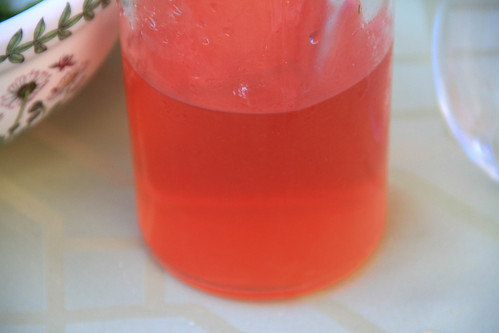
Doesn't that look pretty? It takes as good as it looks, too, tart and flavorful, especially good when chilled. You could do some great cocktails with it, dilute with soda water, or simply sip it from a shotglass. (Don't shoot it, though, that'd be a waste!)
Agurksalat | Cucumber-dill salad | Recipe
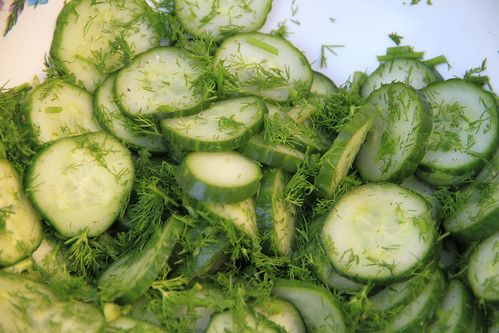
Sweet, tangy, and extremely crispy and refreshing thanks to the ice-bath soak. As far as I'm concerned this is now my Platonic ideal of a cucumber salad.
Gravet laks | Salt-cured salmon | Recipe

So easy to make, and so impressive. A few minutes of plastering the fish with salt, sugar and dill (the name translates as "buried salmon"), turning it over once or twice a day in the fridge for a few days, and you're done. In fact, the most time-consuming and challenging part is the slicing, which Erika thankfully took care of. She shared a pro tip, that if you put the salmon in the freezer for a little bit, the firmer flesh is easier to slice. Relatedly, this dish freezes really well, just defrost and eat, so as long as you're making it you may as well make a lot. Oh, and don't forget to make the classic mustard-dill sauce to accompany.
Rekesalat | Shrimp salad | Recipe
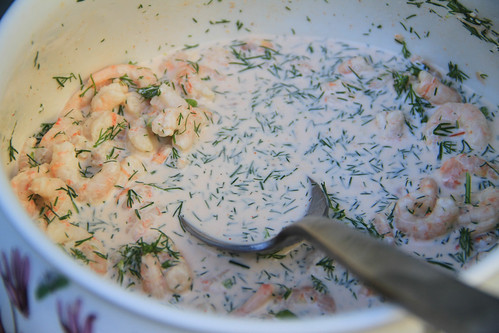
There's more treats in the Norwegian sea. We had some little jars of various pickled herrings, and also this nice little shrimp salad, which in typical style features a lot of dill. This is a good opportunity to share an anecdote about why Norwegians traditionally don't eat predator fish: it's feared that any one of them have eaten part of a friend or relative who died at sea, so it's an abundance of caution to avoid being a second-hand cannibal.
Rabarbrasuppe | Cold rhubarb soup | Recipe
Just about the simplest way to eat this vegetable we treat as a fruit. Cook with water and sugar, chill, serve. It's a vibrant pink and exposes in the most essential way the complex flavor of this very cold-hardy late-spring treat. I tipped the leftovers into the ice cream machine and it made a fantastic sorbet.
Rømmegrøt | Cream pudding | Recipe

Heavy cream, sour cream, milk and buttermilk, totaling nine cups. And a cup of flour. This is one of the richest things I've ever eaten, and while more than a little tangy with that sour cream and buttermilk, it was pleasantly balanced out with cinnamon and sugar. It's the culinary opposite of Midsummer, and indeed it's best known as a Christmas Eve dish. You could see why someone would want to eat this in the middle of a dark and cold winter.
Nypoteter | New potatoes
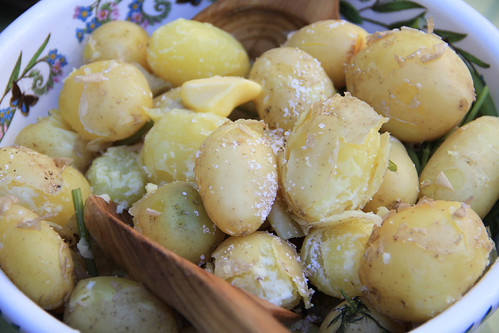
A true new potato is so delicate you can rub the skin off an uncooked one with your thumb, and unlike most potatoes really ought to be kept refrigerated and hence is only available around the late-spring/early-summer harvest time. It has a texture that's both flaky and creamy, with a much brighter flavor than a typical potato. As far as I'm concerned there's only one way to cook new potatoes: boiled, drained, and tossed with butter and a bit of salt. Oh, and because it's Scandinavia, a healthy helping of dill too.
Kjøttkaker | Meatballs | Recipe
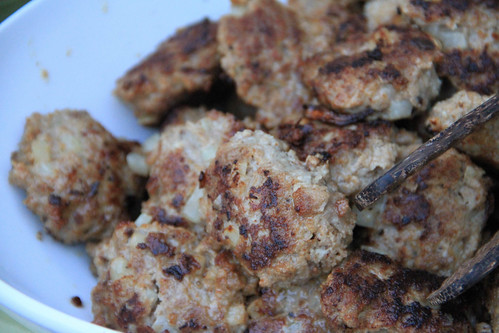
Compared to the more famous Swedish meatballs, these have more spices, and are a little bigger and flatter. The balls were as tasty as they look; the sauce was a lot of work and not my favorite, which is likely because of the brunost — a unique "cheese" that's actually made of caramelized whey.
Vafler | Waffles
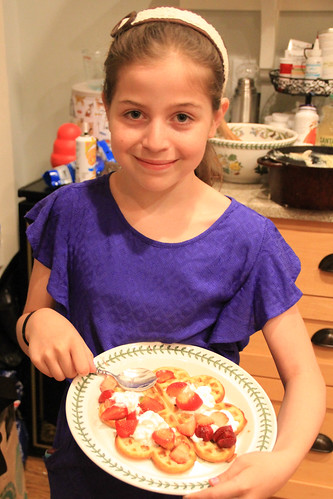
I made so many dishes that I ran out of time to assemble the cake. I baked it, but just didn't have the time to make it up, so I froze it. And everyone wanted waffles anyway. Maya did a super good job of making them (unfortunately I've lost the recipes we used!), covering them with strawberries, and making everyone happy.